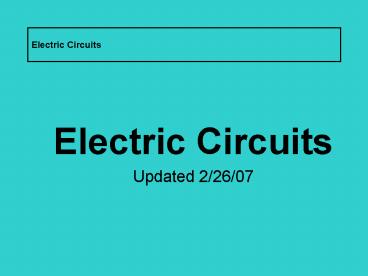Electric Circuits - PowerPoint PPT Presentation
1 / 23
Title:
Electric Circuits
Description:
Ammeter. Ohmmeter. Diode. Definitions ... ammeter measures current. ... ammeter must be connected in series. voltmeter must be placed in parallel. ... – PowerPoint PPT presentation
Number of Views:121
Avg rating:3.0/5.0
Title: Electric Circuits
1
Electric Circuits
- Electric Circuits
- Updated 2/26/07
2
Electric Circuits
- Circuit Symbols
- Battery Cell
- (long is )
- Lamp
- Capacitor
- Ground
Circuit Symbols Resistor Voltmeter Ammeter O
hmmeter Diode
3
Electric Circuits
- Definitions
- electrical circuit a complete conducting path.
To be useful, a circuit must include a source of
electromotive force (emf) and a load
(resistance). - A circuit that includes an emf source but no load
is a short circuit.
4
Electric Circuits
- Consider the circuit shown
- Imagine a quantity of positive charge, DQ, moving
around the circuit from point A back to point A
5
Electric Circuits
- Point A is grounded and its PE is zero
- As the charge moves through the battery from A to
B, the PE of the system increases by DQDV - The chemical energy of the battery decreases by
the same amount
6
Electric Circuits
- As the charge moves through the resistor, from C
to D, it loses energy in collisions with the
atoms of the resistor - The energy is transferred to internal energy
- When the charge returns to A, the net result is
that some chemical energy of the battery has been
delivered to the resistor and caused its
temperature to rise
7
Electric Circuits
- Definitions
- electromotive force (emf) the total energy
difference per unit charge (or work per unit
charge) around a circuit. - One emf source is a battery. (Another is a
generator.) Some of a batteries energy is used
up within the battery itself. This internal load
is called the internal resistance of the battery.
8
Electric Circuits
- A real battery has some internal resistance
- Therefore, the terminal voltage is not equal to
the total emf of the battery
9
Electric Circuits
- The schematic shows the internal resistance, r
- The terminal voltage is ?V Vb-Va
- ?V e Ir
- For the entire circuit, e IR Ir
10
Electric Circuits
- Elements of a circuit can be connected in series
or parallel. - Ohms law applies both to an entire circuit and
each of the elements in a circuit. - A schematic diagram is a drawing of an electrical
circuit.
11
Electric Circuits
- Series Resistance
- Potentials add
- ?V IR1 IR2 I (R1R2)
- The equivalent resistance has the same effect on
the circuit as the original combination of
resistors
12
Electric Circuits
- Resistance
- Series
- Rs R1 R2 Rn
- Parallel
- 1 1 1 1
- Rp R1 R2 Rn
13
Electric Circuits
- Resistance Example
14
Electric Circuits
- Parallel Resistance
- The potential difference across each resistor is
the same because each is connected directly
across the battery terminals. - The current, I, that enters a point must be equal
to the total current leaving that point. - I I1 I2
- The currents are generally not the same.
15
Electric Circuits
- Parallel Resistance
- Household circuits are wired so the electrical
devices are connected in parallel
16
Electric Circuits
- Parallel Resistance
- The inverse of the equivalent resistance of two
or more resistors connected in parallel is the
algebraic sum of the inverses of the individual
resistance
17
- Equivalent
- Resistance
- Req R1R2 R3
18
Electric Circuits
- Capacitance
- Series
- 1 1 1 1
- Cs C1 C2 Cn
- Parallel
- Cp C1 C2 C3
19
Electric Circuits
- Power
- P I V (units are watts)
- since V I R (Ohms Law)
- P I2 R (units are watts)
- P V2 / R (units are watts)
- (Assumes I is amps, V is volts and r is ohms)
20
Electric Circuits
- Power
- The SI unit of power is Watt (W).
- The unit of energy used by electric companies is
the kilowatt-hour - This is defined in terms of the unit of power and
the amount of time it is supplied - 1 kWh 3.60 x 106 J
21
Electric Circuits
- Electric Meters
- ammeter measures current. Must be connected in
series at the point the current needs to be
measured. - voltmeter measures potential difference. Must
be placed in parallel with the component to be
measured. A perfect voltmeter has infinite
resistance.
22
Electric Circuits
- ammeter must be connected in series.
- voltmeter must be placed in parallel.
23
Electric Circuits
- End of Electric Circuits































